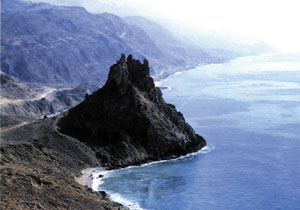
Al-MAHRA: A history narrates itself [Archives:2005/895/Last Page]
November 17 2005
 |
YASSER AL-MAYASI
YEMEN TIMES STAFF
ESHRAQ AL-BODIGI
FOR YEMEN TIMES
It is 522km away from Mukallah and 1400km to the east Sana'a; linked by the Marib-Shabwa-Mukallah Road. It is situated in the eastern part of Yemen on the Arabian Sea, extending eastwards as far as the international borders with Oman, to the north as far as Al-Ruba Al-Khali Desert (Empty Quarter) and to the west to the Massela valley in Hadhramout. Al-Ghai'dha is the provincial capital city of _Al-Mahra.
Topographically, Al-Mahra consists of mountainous region, representing an extension of Oman and Hadhramout Mountains of 400-1000m in elevation above sea level, and valleys, some of which stretch northwards to the Empty Quarter.
The western valleys join Wadi Al-Massela extending to Saihout. Some of the valleys are perennial springs; Al-Mahra also includes spacious areas of fertile arable lands.
It is believed that Al-Mahra is one of the most important natural habitats of the frankincense tree in east Hadhramout, which was used to be of great importance in the old world. The trading camel caravans were carrying that commodity from Mahra across Hadhramout valley as far as Shabwa and then on the Frankincense famous road as far as Gaza on the Mediterranean.
Al-Mahra was used to have a prominent role in the history of ancient Yemen and was referred to in different inscriptions. During its contemporary history, the Sultans of Al-Toghr Bin Afran ruled it for some periods.
Most of the population of Al-Mahra are engaged in agriculture, cattle raising and fishing as its rich water of the Arabian Sea provides high potential in the domain of fishing. Al-Mahra is famous for its rock lobster and shrimps, which are exported through the port of Nashtoon.
There are many beautiful beaches, stretching from Saihout in the west to Hauf in the east, offering great service to tourists.
The people of Al-Mahra have maintained their Arab traditions and customs that have not been affected by external influences. They speak, in addition to Arabic, a local unwritten language called Mahri, which has its roots in the ancient language of south Arabia.
History of Colonies in AL-Mahra
The history of colonialism of Al-Mahra areas dates back to very old times; many of its colonies dates back to the B.C. periods such as:
– Old Stone Age colonies: this kind of colonies was found in AL-Gaza valley that extends to the Arabian Sea to the west of Al-Ghai'dha.
Some of stone tools, which related to Ashwalean civilization, were found in those settlements as far as some sites that date back to 150.000 years B.C. were also found in the Kasheen and nearer to the Arab Gulf Shores.
– Modern Stone Age colonies: most of its sites were found in the northern desert of Thamoud, Sanaw, and Habroot zone. These sites date bake to 2500-6000 years B.C.
In addition, there are many colonies from the Bronze Age, which were found in different sites that some of stony patterns are spread over there. The most important site of which; an area near to the Al-Ghai'dha city.
However, a number of settlements from the Iron Age historical period, and Islamic period are extend in lots of sites in Al-Mahra governorate.
Some Historical Mahri Towns
AL-Mahra has so many historical and tourist places and towns, which every one of them has special astonishing natural features that attract numerous tourists from everywhere to see the greatness of God and the beauty of nature. Among them are Hauf, Al-Ghai'dha, Habroot, Kasheen, Mana'ar, and Zaboot.
Hauf
Hauf is one of the most beautiful provinces in AL-Mahra and in Yemen, as a whole; the Almighty God gave it a very wonderful nature. It is an engrafted mixture with a magic natural soil of green agriculture, water, trees, birds, and animals.
Hauf has complete natural features that show the sea and dense forests. It is really the most beautiful province in the east of Yemen.
Kasheen
Kasheen city was the first capital of AL-Mahra and Socotra; is very famous, old and highbred. This town is an agricultural area, and an archeological place with a very ancient history and that seems very clear through the existence of the vestigial settlements on its land.
Damqut
It is the oldest zone in AL-Hauf province; passes through two historical periods, the Pre-Islam and Islamic one. It is approximately 94km to the east of Al-Ghai'dha and located between two mountains that lie at the entrance of the Seek valley.
Damqut has a mountain range that contains some of the Sabaen engravings and its land is full of the frankincense trees.
The Mountains in Al-Mahra Governorate
There is a mountainous plateau in Al-Mahra governorate as extension of Oman and Hadhramout mountain chains heights are between 400-1000m above sea level.
Some of these mountains have a number of caves and grottos, which were used for keeping food and quarry in the past ages; others, like Mararah Mountain, have a number of hot springs.
——
[archive-e:895-v:14-y:2005-d:2005-11-17-p:lastpage]


